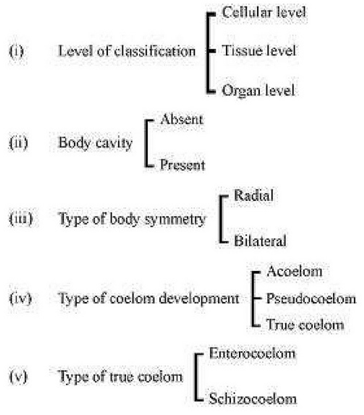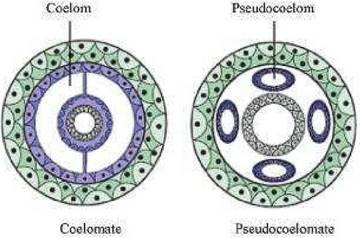Animal Kingdom - Solutions
CBSE Class 11 Biology
1. What are the difficulties that you would face in classification of animals, if common fundamental features are not taken into account?
Ans. For the classification of living organisms, common fundamental characteristics are considered.If we consider specific characteristics, then each organism will be placed in a separate group and the entire objective of classification would not be achieved. Classification of animals is also important in comparing different organisms and judging their individual evolutionary significance. If only a single characteristic is considered, then this objective would not be achieved.
2. If you are given a specimen, what are the steps that you would follow to classify it?
Ans. There is a certain common fundamental feature that helps in classification of living organisms. The features that can be used in classification are as follows.

On the basis of above features, we can easily classify a specimen into its respective category.
3. How useful is the study of the nature of body cavity and coelom in the classification of animals?
Ans. Coelom is a fluid filled space between the body wall and digestive tract. The presence or absence of body cavity or coelom plays a very important role in the classification of animals. Animals that possess a fluid filled cavity between body wall and digestive tract are known as coelomates. Annelids, mollusks, arthropods, echinodermates, and chordates are examples of coelomates. On the other hand, the animals in which the body cavity is not lined by mesoderm are known as pseudocoelomates. In such animals, mesoderm is scattered in between ectoderm and endoderm. Aschelminthes is an example of pseudocoelomates. In certain animals, the body cavity is absent. They are known as acoelomates. An example of acoelomates is platyhelminthes.

4. Distinguish between intracellular and extracellular digestion?
Ans.
Intracellular Digestion | Extracellular Digestion |
i. It occurs within the cells. ii. Only a few enzymes are associated with this digestion. iii. It occurs in unicellular organisms and some lower organisms. iv. It is less efficient and there is no regional differentiation. | i. It occurs outside the cells in the cavity of the alimentary canal. ii. Large number of digestive glands and enzymes are associated with this digestion. iii. It occurs inmulticellularorganisms. iv. It is more efficient and the gut shows regional differentiation. |
5. What is the difference between direct and indirect development?
Ans.
Direct development | Indirect development |
1. In direct development, the young animal resembles an adult. 2. There is no intermediate stage, for example - Hydra, earthworm and human beings. | 1. In indirect development, the young animal does not resemble an adult. 2. In indirect development, the young ones usually pass through one or more intermediate stages before obtaining the shape of an adult. For example, frogs before being developed into adult pass through a tadpole stage. |
6. What are the peculiar features that you find in parasitic platyhelminthes?
Ans. Peculiar features in parasitic platyhelminthes are as follows.
1. They have dorsiventrally flattened body and bear hooks and suckers to get attached inside the body of the host.
2. Their body is covered with thick tegument, which protects them from the action of digestive juices of the host.
3. The tegument also helps in absorbing nutrients from the host’s body.
7. What are the reasons that you can think of for the arthropods to constitute the largest group of the animal kingdom?
Ans. The phylum, Arthropoda, consists of more than two-thirds of the animal species on earth. The reasons for the success of arthropods are as follows.
i. Jointed legs that allow more mobility on land
ii. Hard exoskeleton made of chitin that protects the body
iii. The hard exoskeleton also reduces water loss from the body of arthropods making them more adapted to terrestrial conditions.
8. Water vascular system is the characteristic of which group of the following:
(a) Porifera (b) Ctenophora (c) Echinodermata (d) Chordata
Ans. (c) Water vascular system is a characteristic feature of the phylum, Echinodermata.
9. “All vertebrates are chordates but all chordates are not vertebrates”. Justify the statement.
Ans. The characteristic features of the phylum, Chordata, include the presence of a notochord and paired pharyngeal gill slits. In sub-phylum Vertebrata, the notochord present in embryos gets replaced by a cartilaginous or bony vertebral column in adults. Thus, it can be said that all vertebrates are chordates but all chordates are not vertebrates.
10. How important is the presence of air bladder in Pisces?
Ans. Gas bladder or air bladder is a gas filled sac present in fishes. It helps in maintaining buoyancy. Thus, it helps fishes to ascend or descend and stay in the water current.
11. What are the modifications that are observed in birds that help them fly?
Ans. Birds have undergone many structural adaptations to suit their aerial life. Some of these adaptations are as follows.
(i) Streamlined body for rapid and smooth movement
(ii) Covering of feathers for insulation
(iii) Forelimbs modified into wings and hind limbs used for walking, perching, and swimming
(iv) Presence of pneumatic bones to reduce weight
(v) Presence of additional air sacs to supplement respiration
12. Could the number of eggs or young ones produced by an oviparous and viviparous mother be equal? Why?
Ans. The numbers of eggs produced by an oviparous mother will be more than the young ones produced by a viviparous mother. This is because in oviparous animals, the development of young ones takes place outside the mother’s body. Their eggs are more prone to environmental conditions and predators. Therefore, to overcome the loss, more eggs are produced by mothers so that even under harsh environmental conditions, some eggs might be able to survive and produce young ones. On the other hand, in viviparous organisms, the development of young ones takes place in safe conditions inside the body of the mother. They are less exposed to environmental conditions and predators. Therefore, there are more chances of their survival and hence, less number of young ones is produced compared to the number of eggs.
13. Segmentation in the body is first observed in which of the following:
(a) Platyhelminthes (b) Aschelminthes (c) Annelida (d) Arthropoda
Ans. The body segmentation first appeared in the phylum, Annelida (annulus meaning little ring).
14. Match the following:
(a) Operculum (b) Parapodia (c) Scales (d) Comb plates (e) Radula (f) Hairs (g) Choanocytes (h) Gill slits | (i) Ctenophora (ii) Mollusca (iii) Porifera (iv) Reptilia (v) Annelida (vi) Cyclostomata and Chondrichthyes (vii) Mammalia (viii) Osteichthyes |
Ans.
(a)-(viii); (b)-(v); (c)-(iv); (d)-(i); (e)-(ii); (f)-(vii); (g)-(iii); (h)-(vi)
15. Prepare a list of some animals that are found parasitic on human beings.
Ans. Parasites on human body:
- Taenia (Tapeworm)
- Ascaris (Round worm)
- Ancylostoma (Hook worm)
- Enterobius (Pin worm)
- Wuchereria (Filarial worm)